Strict Standards: Only variables should be assigned by reference in /home/noahjames7/public_html/modules/mod_flexi_customcode/tmpl/default.php on line 24
Strict Standards: Non-static method modFlexiCustomCode::parsePHPviaFile() should not be called statically in /home/noahjames7/public_html/modules/mod_flexi_customcode/tmpl/default.php on line 54
Strict Standards: Only variables should be assigned by reference in /home/noahjames7/public_html/components/com_grid/GridBuilder.php on line 29
Transportation has always been a big part of our far-out visions of the future, whether we imagine flying cars, ultra-fast tubes or Star Trek-style contraptions. While chances are slim that we'll be de-materializing and re-materializing in another spot anytime soon, fast-advancing technology will change the way we get from point A to point B in the near future. Here are the most promising advances.
Hyperloop
Undoubtedly, the Hyperloop is the most futuristic of current transportation proposals. Put forward by Tesla and Space X founder Elon Musk, the Hyperloop is envisaged as a steel tube along which pods about the size of cars travel at up to 760 miles per hour (1,220 kmph) -- faster than jet aircraft.
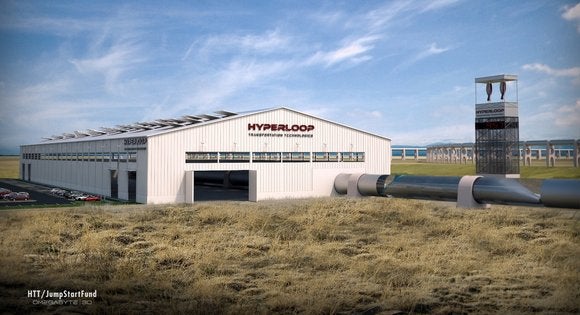 Hyperloop Transportation Technologies
Hyperloop Transportation TechnologiesAn artist's image of a proposed Hyperloop transport system under development by Hyperloop Transportation Technologies.
The Hyperloop tube is kept at a partial vacuum, reducing air resistance, and each pod sits on a cushion of air similar to the way a puck sits on an air hockey table. The pods are propelled and slowed by linear induction motors placed at regular intervals along the tube, and a large fan at the front of the pod forces air in front of the pod to behind it, avoiding a pressure build-up that would otherwise slow the craft.
Musk reckons a Hyperloop trip between San Francisco and Los Angeles would take about 35 minutes -- faster than flying and a huge improvement over the 6-hour car journey.
But it's still a dream. Engineers at Musk's companies worked on designs for Hyperloop for a year, but it remains just a concept. To help push it forward, a 57-page white paper detailing the work was published online in August 2013 and Musk asked people to build and improve upon it.
Some are already doing that.
Hyperloop Technologies in Los Angeles envisages the system will be used to transport freight, not people, and one of the routes it's looking at would connect Las Vegas and California. Another would ferry goods up and down the U.S. Pacific coast, and there is even talk of one connecting the manufacturing hubs of Asia with North America.
A company with a similar name, Hyperloop Transportation Technologies, already has 400 people working on plans for an actual service -- but don't get too excited. It will run about 5 miles in Quay Valley, a proposed eco-city in central California that itself is a grandiose plan and yet to be built. The service could start as soon as 2018, but $100 million in funding is required ... as is a town and its residents.
 Hyperloop Transportation Technologies
Hyperloop Transportation TechnologiesAn artist's image of a proposed Hyperloop test track being designed by Hyperloop Transportation Technologies
Perhaps the most concrete Hyperloop plan is one funded by Musk himself. While he hasn't committed to building a commercial Hyperloop, Musk does plan to build a test track that will be open to companies and students to test projects based on the technology. Musk hasn't revealed the location, but said in a Tweet that it will most likely be in Texas.
Beyond the technology, there are plenty of other hurdles to overcome.
California has been talking about a high-speed rail line between San Francisco and Los Angeles since the mid-nineties, but a single mile of track still hasn't been laid.
The $68 billion estimated price of the system is controversial in a state that likes to think it's environmentally friendly, but in reality is in love with air travel and cars. State and local politics are just as likely to get in the way of the Hyperloop, especially if it's to snake through the wealthy suburbs of Silicon Valley and Los Angeles.
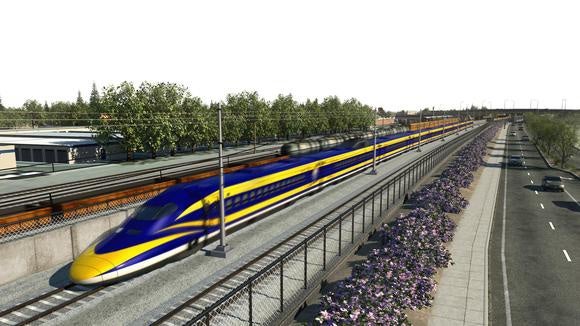 California High Speed Rail
California High Speed RailAn artist's conceptual rendering of California's High Speed Rail system
And then there's mother Earth herself. California is one of the most earthquake prone regions in the U.S. and gets many small, localized quakes and occasionally quite large ones. Seismic durability is a hot topic for the proposed high-speed rail link, and the Hyperloop is envisaged to be traveling much faster, so designers will have to come up with a system that can safely bring a pod to a halt in the event of a large earthquake.
Driverless Cars
While the Hyperloop represents Silicon Valley's greatest blue-sky thinking, driverless cars are much closer to reality.
The seeds were sown in 2004 when the Defense Advanced Research Projects Agency (DARPA) set a challenge: complete a 150-mile course in central California without a driver.
As a race, it was a failure. The winner completed just over 7 miles. But it helped kick-start numerous development projects. For example, the roof-mounted laser scanner that's become the most recognizable feature of Google's prototype self-driving cars was first developed for the race.
 DARPA
DARPAStanford University's Stanley self-driving car, which won the DARPA Challenge in 2005
Production cars started getting early autonomous features at about the same time. They included the ability to stay in lane or reverse into a parking space, and technology has been progressing since then.
The next big step is expected later this year when Tesla adds an "autopilot" mode to its Model S sedan car. It will initially work on highways, not local streets, and tests appear to be going well.
 Melissa Aparicio
Melissa AparicioNvidia chief executive Jen-Hsun Huang interviews Tesla Motors founder Elon Musk at the Nvidia GPU Technology Conference 2015.
"We're now almost able to travel all the way from San Francisco to Seattle without the driver touching any controls at all," Musk said when he announced the technology in March.
General Motors is hot on Tesla's tail, with plans to introduce a similar mode in its Cadillac cars due out in 2016. The feature, probably appearing first on high-end models, is expected to be an automatic cruise control system that keeps the car within the lane with steering adjustments and automatically adjusts the speed to keep the passengers safe.
As with the Tesla system, GM's technology will initially be limited to highways. That's because there are many fewer variables at play on a long, straight, fast-moving highway than on residential streets.
"Highway cruise is easy, low speed is easy; it's medium that's hard," Musk said. "Being able to recognize what you're seeing and make the right decision in that suburban environment in that 10 mph to 50 mph zone is the challenging portion."
The holy grail of fully autonomous driving is still many years away.
That's because it's incredibly difficult to program cars to recognize and handle every possible situation that can arise. Just look at some of the crazy dashboard camera videos on YouTube and you'll see the kind of things drivers can face on the road. Developing software to recognize, analyze, sort and act on that in a split second is difficult.
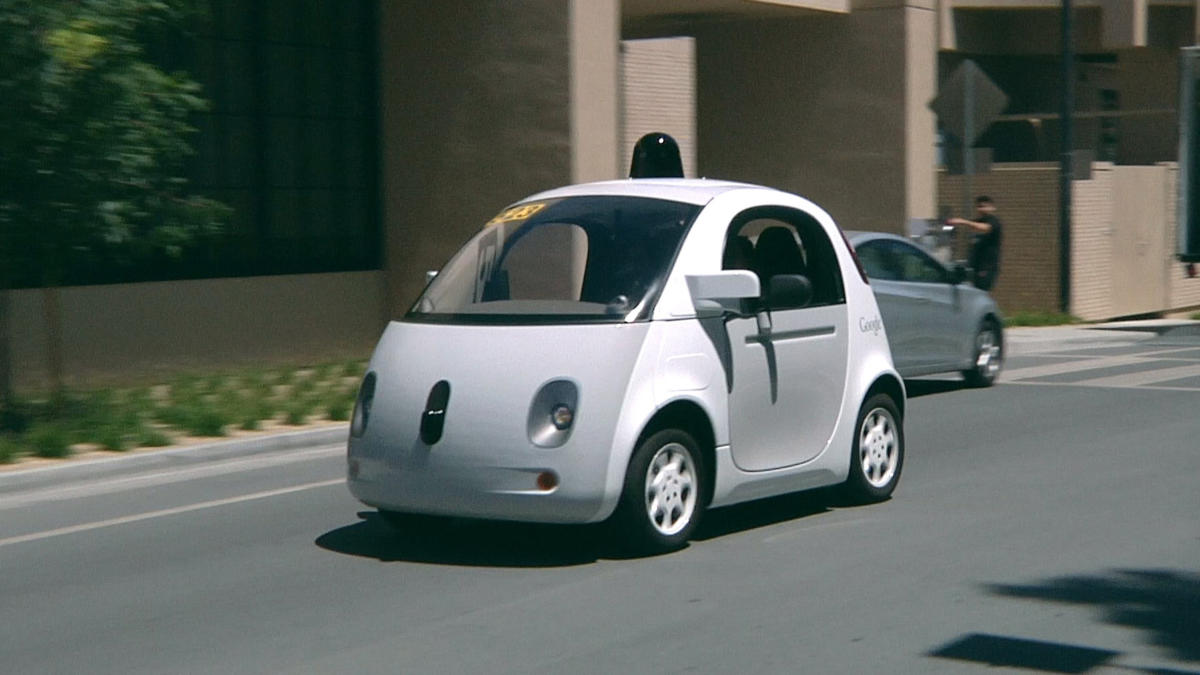 Martyn Williams
Martyn WilliamsA Google self-driving navigates streets near the company's headquarters in Mountain View, California, on June 29, 2015.
Just getting a car to drive on a clear, open road is hard enough. Google's cars can do it, but they continuously scan their surroundings and match that to a database that's already been mapped, meaning they can only travel along roads for which data exists in the system.
For an impressive demonstration of state-of-the-art technology, look to Shelley, a converted Audi TTS Coupe developed by students at Stanford University. It can race around a track at up to 120 miles per hour without a person inside. Shelley is packed with sensors, computers and radios that calculate the forces on the car and where exactly it sits on the road, so it can drive as fast as possible without having an accident.
 Martyn Williams
Martyn WilliamsStanford's Shelley prototype self-driving car seen at the university in May 2012.
And for a tantalizing look at the future of car travel, check out the Mercedes Benz F015, a concept driverless vehicle that was unveiled at this year's Detroit Motor Show.
The interior is covered in touch-panel displays, and the front two seats twist around so that up to four passengers can sit and chat while the car takes care of the mundane job of driving. It's almost universally been described as "space age" and it has that futuristic look to it too. A production F015 is at least a decade or more away.
 Martyn Williams
Martyn WilliamsThe interior of the Mercedes Benz F015 concept car has seats that face each other because the car will do all the driving, seen here at the North American International Auto Show in Detroit on January 13, 2015.
In fact, autonomous technology might come first to the much less sexy world of freight haulage.
Fatigue is a leading cause of trucking accidents, and truck makers see autonomous driving as a way to cut down on accidents and deaths.
Volvo has been studying the idea of road trains as part of a European Union project. The idea is simple: a procession of cars or trucks each automatically follows the one in front as they travel down the highway. The only driver who needs to be paying attention is the one at the head of the procession, as the others will speed up and slow down in time with the lead car.
Such a system is only possible if vehicles can communicate with each other -- something that automakers are working on but for which there is still no standard.
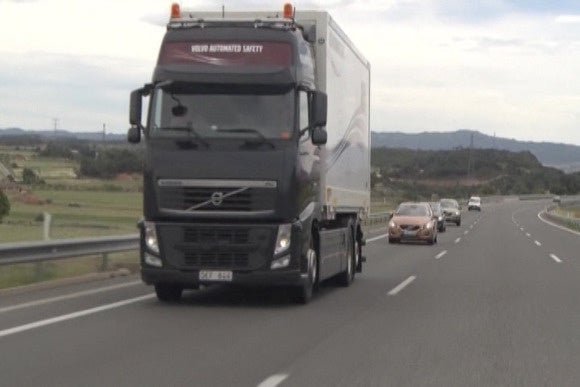 Volvo
VolvoA Volvo truck heads a road train of cars that are following automatically during tests in Sweden in 2012.
In the U.S., Daimler recently demonstrated a truck called the Freightliner Inspiration that includes an autopilot mode. For use on highways, it will keep the truck in its lane and a safe distance and speed from other cars, but it's only permitted in Nevada. Regulations of such matters are handled on a state-by-state basis in the U.S.
A recent survey by Boston Consulting Group found 55 percent of 1,510 U.S. consumers questioned thought themselves likely or very likely to at least consider purchasing a partially autonomous car over the next 10 years. But that drops to 44 percent when asked about a fully autonomous car.
One of the most requested features is the ability to take over in heavy traffic. There's perhaps nothing more frustrating than sitting behind the wheel in a traffic jam, inching forward slowly while you wait out the queue.
Alternative Fuels
The age of the electric car is firmly here. In Silicon Valley, electric cars like Nissan's Leaf and the Tesla Model S are a regular sight, thanks in part to generous state incentives. Now similar incentives might be helping usher in the age of hydrogen cars.
These are cousins of electric cars in that they have the same drive train but the electricity to power the car's motor comes from a fuel cell rather than a battery. The fuel cell takes hydrogen from a tank and strips off electrons to produce a flow of electricity. The only byproduct is water, so it's being pushed by automakers as a very clean alternative to gasoline, and because the hydrogen tank can be refilled in just a few minutes, it's much more convenient than electric cars, which might require several hours of charging.
Unfortunately, it's still quite energy-intensive to produce hydrogen in a form suitable for cars, so the entire energy chain isn't as green as it could be.
Car makers have been testing fuel cells for years and Toyota and Honda are now on the verge of commercializing the technology. Toyota's hydrogen fuel cell car, the Mirai, will go on sale this year in California and can travel about 300 miles on a single charge of hydrogen. Refilling the tank takes about five minutes -- much faster than a comparable charge for an electric vehicle.
 Martyn Williams
Martyn WilliamsToyota's Mirai hydrogen fuel cell vehicle on show at CES 2015 in Las Vegas on January 5, 2015.
Filling up on hydrogen is a challenge because only a handful of hydrogen recharging stations exist in the state. But California has committed to building a network of several hundred to support the technology.
Urban Mobility
The final step in future transportation concerns how we get around towns and cities after we've journeyed there by car or train.
Perhaps the most famous idea was the Segway, which launched in 2001 as the future of urban transportation but has found niche applications at best.
That hasn't stopped others from looking at the technology, including Toyota and Honda.
 Martyn Williams
Martyn WilliamsA model demonstrates the Toyota Winglet robotic transporter at a Tokyo news conference on August 1, 2008.
The Toyota Winglet prototype is a two-wheeler that the rider stands on, much like the Segway. But it's much smaller and lighter. It has been tested in an airport in Japan, but as yet there are no plans to commercialize it.
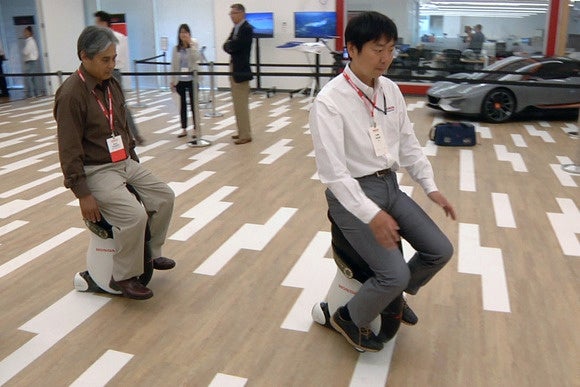 Martyn Williams
Martyn WilliamsRiders try out Honda's Uni-Cub during an event at the company's Silicon Valley R&D Center in Mountain View on July 23, 2015.
Honda's Uni-Cub is a single wheeler with an integrated seat. An ingenious two-wheels-in-one arrangement means it can move forwards and sideways on its wheel. Like the Winglet, there are no plans to commercialize it.
Holland's Oxboard has come up with an even more compact way to get around town. You have to stand and be pretty steady, but it's easy to get used to and moves surprisingly fast.
Predicting the future is perilous, but with congestion in cities only worsening, and a desperate need to find less carbon-intensive modes of transport, it’s only a matter of time before freeways and city streets start to look like very different places.
Strict Standards: Only variables should be assigned by reference in /home/noahjames7/public_html/modules/mod_flexi_customcode/tmpl/default.php on line 24
Strict Standards: Non-static method modFlexiCustomCode::parsePHPviaFile() should not be called statically in /home/noahjames7/public_html/modules/mod_flexi_customcode/tmpl/default.php on line 54
Find out more by searching for it!
